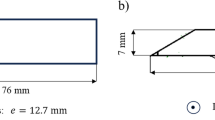Abstract
Two types of multilayer material have been studied: a self-sharpening composite with a wear-resistant layer in the middle and soft outer layers, and a layered macrocomposite made by alternating two layers with a different graphite content. It is established that the powder rolling method and appropriate thermomechanical treatment make it possible to prepare materials with markedly different layer-by-layer hardness and high hardness for the pearlitic component. These materials may be used for preparing cutting tools with a self-sharpening effect and high operating life.
Similar content being viewed by others
REFERENCES
V. N. Tkachev (ed.), Advanced Methods for Increasing the Quality, Life, and Reliability of Machine Components for Animal Husbandry and Feed Production: Coll. Works [in Russian], Rostov-on-Don (1980).
N. I. Voloshko and A. I. Rogov, Impact Strength of Cutting Elements: Coll. Works [in Russian], Kharkov Agric. Inst., Kharkov (1981).
N. I. Voloshko, A. T. Tsirkin, and A. I. Rogov, “Method for preparing multilayer materials for agricultural machine cutters by powder metallurgy, ” in: Improvement of the Construction, Better Maintenance and Operation of Agricultural Machines: Coll. Works [in Russian], Kharkov Agric. Inst., Kharkov (1976).
I. N. Sheenko, V. D. Oreshkin, and Yu. D. Repkin, Modern Surfacing Materials Based on Refractory Compounds [in Russian], Nauk. Dumka, Kiev (1970).
A. P. Gulyaev, Metal Science, 4th ed., revised [in Russian], Metallurgiya, Moscow (1966).
N. I. Voloshko, A. I. Rogov, and M. F. Permigin, “Abrasive wear rate for three-layer cutters prepared by powder metallurgy, ” Poroshk. Metall., No. 7, 100–102 (1981).
A. K. Radchenko, O. A. Katrus, V. I. Bondarenko, et al., “Obtaining-well-forming iron powders by rolling in rolling mill, ” Int. Conf. Advanced Materials, Symp. A: Engineering of Composites: Investigations, Technologies and Perspectives, Abstr., Kiev (1999).
I. G. Chernysh, I. G. Nikitin, and N. V. Levental', “Study of thermally-expanded graphite formation,” Poroshk. Metall., No. 6, 17–20 (1991).
O. A. Katrus, “Calculation of production parameters for rolling strip from powders via their bulk density, ” Poroshk. Metall., No. 2, 9–15 (1981).
V. M. Paryshev and Yu. A. Shotkin, “Study of rolling powder mixtures with a filler in the form of solid lubricant, ” Poroshk. Metall., No. 10, 9–13 (1976).
I. M. Fedorchenko and L. I. Pugina, Composite Sintered Antifriction Materials [in Russian], Nauk. Dumka, Kiev (1980).
R. Z. Vlasyuk, “Carburization of austenite during sintering compacts made from a mixture of iron powder with graphite, ” Poroshk. Metall., No. 3, 34–37 (1992).
V. S. Zolotarevskii, Mechanical Properties of Metals, 2nd ed., revised and supplemented [in Russian], Metallurgiya, Moscow (1983).
O. M. Perel'man, V. Yu. Gorokhov, N. V. Bezmaternykh, et al., “Powder materials for operating elements of submerged centrifugal pumps, ” Neftyanoe Khoz., No. 6, 7–11 (1996).
Author information
Authors and Affiliations
Rights and permissions
About this article
Cite this article
Radchenko, A.K., Gogaeva, T.K. Multilayer Steel Composite Prepared by Rolling. Powder Metallurgy and Metal Ceramics 42, 336–340 (2003). https://doi.org/10.1023/B:PMMC.0000004152.75232.34
Issue Date:
DOI: https://doi.org/10.1023/B:PMMC.0000004152.75232.34




